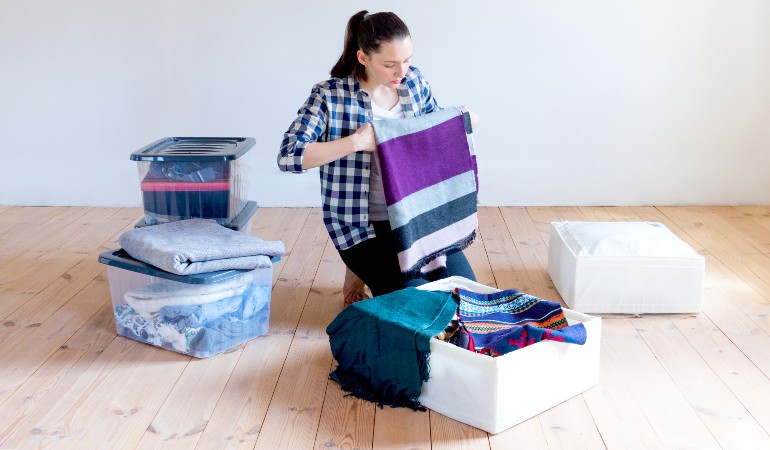
For one reason or another, there comes a time when you’ll need to store your clothes for the long term. Whether you need to put away your seasonal wear or you are travelling for an extended period, you’ll find it necessary to prepare your clothes for storage.
When it comes to storing clothes for the long term, proper care and organisation are key to ensuring longevity and maintaining good condition. From sorting your clothes to selecting appropriate containers, we will list all the steps to keeping your clothes long-term in the best way possible.
With these tips, you’ll be able to maintain your favourite wardrobe pieces ready for future use, all while maximising space at home and preserving your clothes’ quality.
Table of Contents
1. Sort and declutter your clothes
First things first, before you store away your clothes, take the time and effort to sort through them. Doing so will not only save space later but also help you organise your clothing for easier storage.
- Go through your wardrobe and separate the clothes you need to store long-term. You can use the classic three-pile method and sort your clothes into three groups – keep, donate, and discard. The “keep” pile should consist of items you love, regularly wear, and are in good condition. The “donate” pile includes clothes that are still wearable but no longer serve you, and the “discard” pile is for clothes that are beyond repair or unsuitable for donation.
- Take each piece of clothing in your hands and evaluate its condition, appearance, and whether it aligns with your current style. Consider whether the clothing you keep is something you genuinely love and wear. If an item is damaged beyond repair, stained, or no longer fits, consider letting it go.
- Once you’re done with the decluttering part, prepare several piles or areas for different clothing categories. This could range from casual and formal attire to adult and children’s wear. Categorising based on your specific needs will help you arrange your clothes for long-term storage and make the process a lot smoother.
2. Clean and dry
A key aspect of preserving clothes for an extended period is to ensure they are thoroughly cleaned and dried before being put away for storage. This simple, yet crucial task sets the foundation for preserving your clothing and preventing any potential damage over time.
Clothes that are stored without being properly cleaned can harbour residual odours, stains, or bacteria. That can lead to unpleasant smells and discolouration, causing clothes to turn yellow.
Also, clothes can retain odours from various sources, such as perfumes, sweat, food, or smoke. If these odours are not properly eliminated before storage, they can become more pronounced over time. Therefore, before you store away your clothes, be sure to clean them according to their specific care instructions.
When putting clothes away for a long period of time, it’s critical to make sure that they are completely dry in order to avoid mould and mildew from developing.
3. Take care and prevent any possible damages
Speaking of keeping your clothes in good condition, you’ll need to deal with any existing damages before storing them long-term, too. Inspect your clothes for any loose buttons, hems, or anything else that might need repairs to prevent them from worsening.
Take off any detachable accessories such as belts, pins, or brooches. Storing coats or any other clothing with attached accessories can cause damage to the fabric over time or create indentations. Fasten buttons and zip up zippers before storing. This helps maintain the shape of the garment and reduces stress on the closures during storage.
To store clothes long-term and prevent mould growth that can damage the fabric, it’s important to take precautions that minimise moisture. Using moisture absorbers like silica gel packets to reduce humidity levels can create a dry environment and help protect your clothes.
Check also:
4. Opt-in for appropriate and durable storage containers

When storing clothes in your house, the most appropriate containers are breathable ones made of fabric or acid-free materials, allowing air circulation. Fabric storage bags or acid-free boxes are also recommended for the optimal preservation of your clothes.
If you choose to use plastic containers, you must ensure they are high-quality, durable, and have secure lids to protect the clothes from dust, pests, and light. To further safeguard delicate items, consider using acid-free plastic containers and wrapping the clothes in tissue paper.
Warning: Avoid using cardboard boxes for long-term storage. While cardboard boxes may seem convenient, they do not provide adequate protection. Moisture can seep through the cardboard, leading to potential damage.
Similarly, vacuum-sealed bags, while space-saving, can compress and deform delicate or natural fibre garments over time, causing them to lose their shape.
5. Fold and pack properly
When it comes to preparing your clothes for long-term storage, proper folding and packing are crucial to maintaining their condition and optimising storage space.
Start by placing heavier clothes like jeans or sweaters at the bottom of your storage container to ensure stability. After that, place the lighter ones on top. This arrangement protects the more delicate items from unnecessary pressure and minimises wrinkles or damage risk.
Choose a folding method that works best for you. The rolling method, for instance, is perfect for t-shirts or lightweight pants. Folding helps maintain order and makes it easier to find specific items later. It also prevents overfilling containers, which protects clothes from losing their shape and making them difficult to retrieve or iron.
On that note, avoid the temptation to overfill your containers. Cramming too many clothes into one container can lead to garments losing their shape and becoming unwieldy to handle. Give your clothes some breathing space by avoiding excessive stuffing.
You Can Store Your Belongings Without Any Worries With Fantastic Removals
Enter your postcode to view our rates and availability in your area.
For questions about the services we offer visit our main site or you can always call us at 020 3746 0584
6. Create an inventory list
Creating an inventory is a crucial step to ensure you keep track of where each piece of clothing is. By making an inventory, you’ll have a clear record of what clothes you have stored and in which containers they are located. This makes the storage process much easier and more efficient, as you’ll know exactly where to find a specific item when you need it.
Having an inventory is particularly beneficial when storing seasonal clothing, as you can quickly identify and switch out items as the seasons change. By taking the time to create an inventory, you’ll have peace of mind knowing that your clothes are well-organised and accessible whenever you need them.
7. Store the clothes in the best possible place
Finding a good place to store your clothes and maintain their condition is quite important. The ideal storage location for clothes must be a clean, dry, and well-ventilated area with stable temperature and humidity levels.
Many people prefer to store their clothes in their garages, lofts, or attics. They are often used to store garden cushions, so why not clothes as well? While they are options to be considered, you must take into account that they don’t exactly cover the criteria for proper clothing storage. Unless you take some measures like:
- Ensure the storage area is clean and dust-free, as particles can settle on clothes over time;
- Opt for a dry environment to prevent moisture buildup. Good ventilation helps maintain airflow and reduces the chances of musty odours. Avoid storing clothes in areas prone to extreme temperature fluctuations;
- Sunlight can cause fabrics to fade and deteriorate over time, so store your clothes away from direct sunlight to prevent discolouration and damage. Install blinds or curtains to block out light if necessary;
- Ensure that the storage area is free from pests such as insects or rodents. Consider using mothballs or cedar blocks to deter moths and other pests
- Avoid direct contact with the garage floor by placing containers on shelves or raised platforms. It’s also advisable to avoid storing clothes directly against exterior walls, which can be prone to temperature fluctuations;
- Don’t stack heavy items on top of clothes to prevent compression and damage.
If you are left out of options or just don’t have the needed space, you can always go for professional storage service providers for assistance. The specialists can help with your long-term storage needs, delivering excellent conditions for your clothes and peace of mind for their preservation.
Check also:
8. Check on the clothes periodically
Checking on your stored clothes is a crucial step in maintaining their condition and preventing any potential damage. Regular inspections allow you to identify and address potential issues such as mould, moisture, and pests before they can cause significant harm.
During these checks, take the time to assess the storage area, inspect the garments for any signs of damage or pests, and make any necessary adjustments or interventions.
By incorporating regular inspections into your clothes storage routine, you can ensure that your outfits are well-maintained and ready to be worn anytime. These simple yet important checks help you catch any issues early on, allowing you to take prompt action and preserve the quality and longevity of your clothes for years to come.
How long should clothes be kept in storage?
The length of time clothes should be kept in storage can vary depending on individual circumstances and preferences. However, it’s generally advisable to limit the duration of storage to 12 months. You can air them and refold them before storing the clothes again to minimise the risk of damage or deterioration.
The type of fabric and the quality of the garments can influence storage duration. For example, delicate fabrics or high-end clothing may require more frequent wear and careful maintenance, while durable everyday wear may withstand more extended storage periods.
The quality of your storage environment plays a significant role in determining how long clothes can be safely stored. If you have created suitable storage conditions, you can extend the storage duration for certain items.
It’s important to note that extended storage periods increase the chances of clothes being subjected to damage and fading. To ensure the longevity and usability of your clothes, consider periodically reassessing your storage needs and regularly reviewing your stored items to determine if they still serve a purpose.
Keeping Your Possessions in Storage Is Easy When You Call Fantastic Removals
Enter your postcode to view our rates and availability in your area.
For questions about the services we offer visit our main site or you can always call us at 020 3746 0584
Takeaways
- Proper care and organisation are essential for storing clothes long-term;
- Using durable storage containers and packing your clothes correctly is also crucial;
- Regularly checking on your stored clothes is important to identify and address any issues before they turn into more serious problems.














